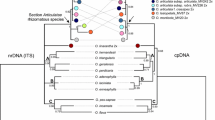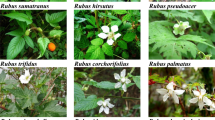Abstract
The sequences of the Internal Transcribed Spacer regions (ITS1 and ITS2) within the genes coding for cytoplasmic ribosomal (r) RNAs on the A chromosome complement of 34 members of the higher plant genus Brachycome (synonym Brachyscome) have been compared. The ITS1 sequence of species within the B. lineariloba complex contains a 56 bp tract that is absent from at least 12 Brachycome species but is present in other species within Brachycome as well as other Asteraceae. Phylogenetic data support the suggestion that the number of chromosomes reduced in several independent Brachycome lineages during speciation. Comparisons with the B chromosome ITS2 of B. dichromosomatica cytodeme A1 suggests an origin of the B chromosome at a time prior to the divergence of the four cytodemes of B. dichromosomatica.
Similar content being viewed by others

References
J Adachi K. Watanabe K. Fukui N. Ohmido K. Kosuge (1997) ArticleTitleChromosomal location and reorganization of the 45S and 5S rDNA in the Brachyscome lineariloba complex (Asteraceae) J. Pl. Res. 110 371–377 Occurrence Handle1:CAS:528:DyaK2sXns1yht78%3D
J. F. Bain R. K. Jansen (1995) ArticleTitleA phylogenetic analysis of the aureoid Senecio (Asteraceae) complex based on ITS sequence data Pl. Syst. Evol. 195 209–219 Occurrence Handle10.1007/BF00989297
B. G. Baldwin (1992) ArticleTitlePhylogenetic utility of the Internal Transcribed Spacers of nuclear ribosomal DNA in plants: an example from the Compositae Mollc. Phylogenet. Evol. 1 IssueID1 3–16 Occurrence Handle1:CAS:528:DyaK3sXms1eksLo%3D Occurrence Handle10.1016/1055-7903(92)90030-K
B. G. Baldwin M. J. Sanderson J. M. Porter M. F. Wojciechowski C.S. Campbell M. J. Donoghue (1995) ArticleTitleThe ITS region of nuclear ribosomal DNA: a valuable source of evidence on angiosperm phylogeny Ann. Missouri Bot. Gardens 82 247–277 Occurrence Handle10.2307/2399880
R. J. Bayer D. E. Soltis P. S. Soltis (1996) ArticleTitlePhylogenetic inferences in Antennaria (Asteraceae: Gnaphalieae: Cassiniinae) based on sequences from nuclear ribosomal DNA Internal Transcribed Spacers (ITS) Amer. J. Bot. 83 IssueID4 516–527 Occurrence Handle1:CAS:528:DyaK28XjtVWltLY%3D Occurrence Handle10.2307/2446220
C. R. Carter (1978) ArticleTitleThe cytology of Brachycome II. The subgenus Metabrachycome: a general survey Austral J. Bot. 26 699–706 Occurrence Handle10.1071/BT9780699
E. Cross C. Quinn S. Wagstaff (2002) ArticleTitleMolecular evidence for the polyphyly of Olearia (Astereae: Asteraceae) Pl. Syst. Evol. 235 99–120 Occurrence Handle1:CAS:528:DC%2BD38Xptleht7s%3D Occurrence Handle10.1007/s00606-002-0198-9
G. Davis (1948) ArticleTitleRevision of the genus Brachycome. 1. Australian species Proc. Linn. Soc. NSW. 73 142–241
T. Denda K. Watanabe K. Kosuge T. Yahara M. Ito (1999) ArticleTitleMolecular phylogeny of Brachycome (Asteraceae) Pl. Syst. Evol. 217 299–311 Occurrence Handle1:CAS:528:DyaK1MXksFSgtbY%3D Occurrence Handle10.1007/BF00984372
T. M. Donald A. Houben C. R. Leach J. N. Timmis (1997) ArticleTitleRibosomal RNA genes specific to the B chromosomes in Brachycome dichromosomatica are not transcribed in leaf tissue Genome 40 674–681 Occurrence Handle9352646 Occurrence Handle1:CAS:528:DyaK2sXntlSgtLw%3D
J. Felsenstein (1993) ``PHYLIP'' Distributed by author. Department of Genetics University of Washington Seattle, USA
A. Houben N. Thompson R. Ahne C. Leach D. Verlin J. Timmis (1999) ArticleTitleA monophyletic origin of the B chromosomes of Brachycome dichromosomatica (Asteraceae) Pl. Syst. Evol. 219 127–135 Occurrence Handle1:CAS:528:DC%2BD3cXhtFOrsL0%3D Occurrence Handle10.1007/BF01090304
James S. H. (1981) Cytoevolutionary patterns, genetic systems and the phytogeography of Australia. In: Keast A. (ed.) Ecological biogeography of Australia Vol 1. The Hague: W. Junk, pp. 761–782.
M. Kimura (1980) ArticleTitleA simple method for estimating evolutionary rates of base substitutions through comparative studies of nucleotide sequences J. Molec Evol. 16 111–120 Occurrence Handle7463489 Occurrence Handle1:CAS:528:DyaL3MXmtFSktg%3D%3D Occurrence Handle10.1007/BF01731581
D. Kyhos C. Carter S. Smith-White (1977) ArticleTitleThe cytology of Brachycome lineariloba. 7. Meiosis in natural hybrids and race relationships Chromosoma 65 81–101 Occurrence Handle10.1007/BF00293131
T. K. Lowrey C. J. Quinn R. K. Taylor R. Chan R. T. Kimball J. C. Nardi ParticleDe (2001) ArticleTitleMolecular and morphological reassessment of relationships within the Vittadinia group of Asterae (Asteraceae) Amer. J. Bot. 88 IssueID7 1279–1289 Occurrence Handle1:CAS:528:DC%2BD3MXlvVKitLo%3D
Nicholas K. B., Nicholas H. B. J. (1997) Genedoc: a tool for editing and annotating multiple sequence alignments. Distributed by author.
R. D. Noyes L. H. Rieseberg (1999) ArticleTitleITS sequence data suggest a single origin for North American Astereae (Asteraceae) and reflect deep geographic divisions in Aster s.l Amer. J. Bot. 86 IssueID3 398–412 Occurrence Handle1:CAS:528:DyaK1MXit1Wmurk%3D Occurrence Handle10.2307/2656761
Salkin E., Thomlinson G., Armstrong B., Courtney B., Peate N., Schaumann M. (1995) Australian Brachyscomes. Brown Prior Anderson Pty. Ltd., Australia.
N. S. Scott J. V. Possingham (1980) ArticleTitleChloroplast DNA in expanding spinach leaves J. Exper. Bot. 123 1081–1092
S. Smith-White C. Carter (1970) ArticleTitleThe cytology of Brachycome lineariloba 2. The chromosome species and their relationships Chromosoma 30 129–153 Occurrence Handle5426549 Occurrence Handle1:STN:280:CS%2BB38fivFU%3D Occurrence Handle10.1007/BF00281996
S. Smith-White C. Carter H. Stace (1970) ArticleTitleThe cytology of Brachycome 1.The subgenus Eubrachycome: a general survey Austral. J. Bot. 18 99–125 Occurrence Handle10.1071/BT9700099
H. Stace S. James (1996) ArticleTitleAnother perspective on cytoevolution in Lobelioideae (Campanulaceae) Amer. J. Bot. 83 IssueID10 1356–1364 Occurrence Handle10.2307/2446124
S. Wagstaff I. Breitwieser (2002) ArticleTitlePhylogenetic relationships of New Zealand Asteraceae inferred from ITS sequences Pl. Syst. Evol. 231 203–224 Occurrence Handle1:CAS:528:DC%2BD38Xks1yisL4%3D Occurrence Handle10.1007/s006060200020
K. Watanabe C. Carter S. Smith-White (1975) ArticleTitleThe cytology of Brachycome lineariloba 5. Chromosome relationships and phylogeny of the Race A cytodemes (n=2) Chromosoma 52 383–397 Occurrence Handle10.1007/BF00364021
Watanabe K., Denda T., Suzuki Y., Kosuge K., Ito M., Short P., Yahara T. (1996) Chromosomal and molecular evolution in the genus Brachyscome (Asteraceae). In: Hind D., Beentje H. (eds.) Compositae: systematics. Proceedings of the International Compositae Conference, Kew, 1994. vol 1: pp. 705–722.
K. Watanabe P. S. Short K. Kosuge S. Smith-White (1991) ArticleTitleThe cytology of Brachyscome Cass - (Asteraceae, Astereae). 11. Hybridization between B. goniocarpa (n=4) and B. dichromosomatica (n=2) Austral J. Bot. 39 475–485 Occurrence Handle1:CAS:528:DyaK38XhvFWiu7s%3D Occurrence Handle10.1071/BT9910475
K. Watanabe P. Short (1992) ArticleTitleChromosome number determinations in Brachycome Cass. (Asteraceae: Asterae) with comments on species delimitation, relationships and cytogeography Muellaria 7 IssueID4 457–471
K. Watanabe P. Short T. Denda K. Kosuge (1999) ArticleTitleChromosome numbers and karyotypes in the Australian Gnaphalieae and Plucheeae (Asteraceae) Austral Syst. Bot. 12 781–802 Occurrence Handle10.1071/SB98030
K. Watanabe S. Smith-White (1987) ArticleTitlePhyletic and evolutionary relationships of Brachycome lineariloba (Compositae) Pl. Syst. Evol. 157 121–141 Occurrence Handle10.1007/BF00936193
K. Watanabe T. Yahara T. Denda K. Kosuge (1999) ArticleTitleChromosomal evolution in the genus Brachyscome (Asteraceae, Asterae): statistical tests regarding correlation between changes in karyotype and habit using phylogenetic information J. Pl. Res. 112 145–161 Occurrence Handle10.1007/PL00013869
T. J. White T. Bruns S. Lee J. Taylor (1990) Amplification and direct sequencing of fungal ribosomal RNA genes for phylogenetics M. Innis D. Gelfand J. Sninsky T. White (Eds) PCR protocols: a guide to methods and applications Academic Press San Diego, California, USA 315–322
Author information
Authors and Affiliations
Corresponding author
Rights and permissions
About this article
Cite this article
Field, B.L., Houben, A., Timmis, J.N. et al. Internal transcribed spacer sequence analyses indicate cytoevolutionary patterns within Brachycome Cass. (Asteraceae). Plant Syst. Evol. 259, 39–51 (2006). https://doi.org/10.1007/s00606-005-0400-y
Received:
Accepted:
Published:
Issue Date:
DOI: https://doi.org/10.1007/s00606-005-0400-y



